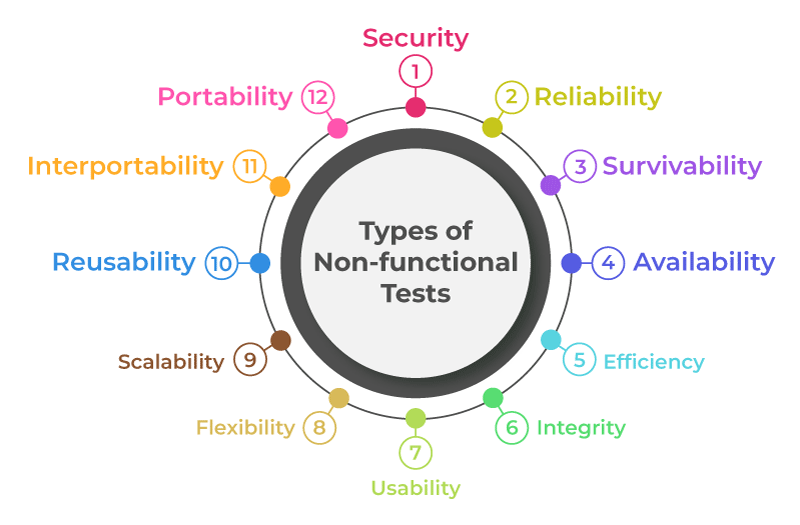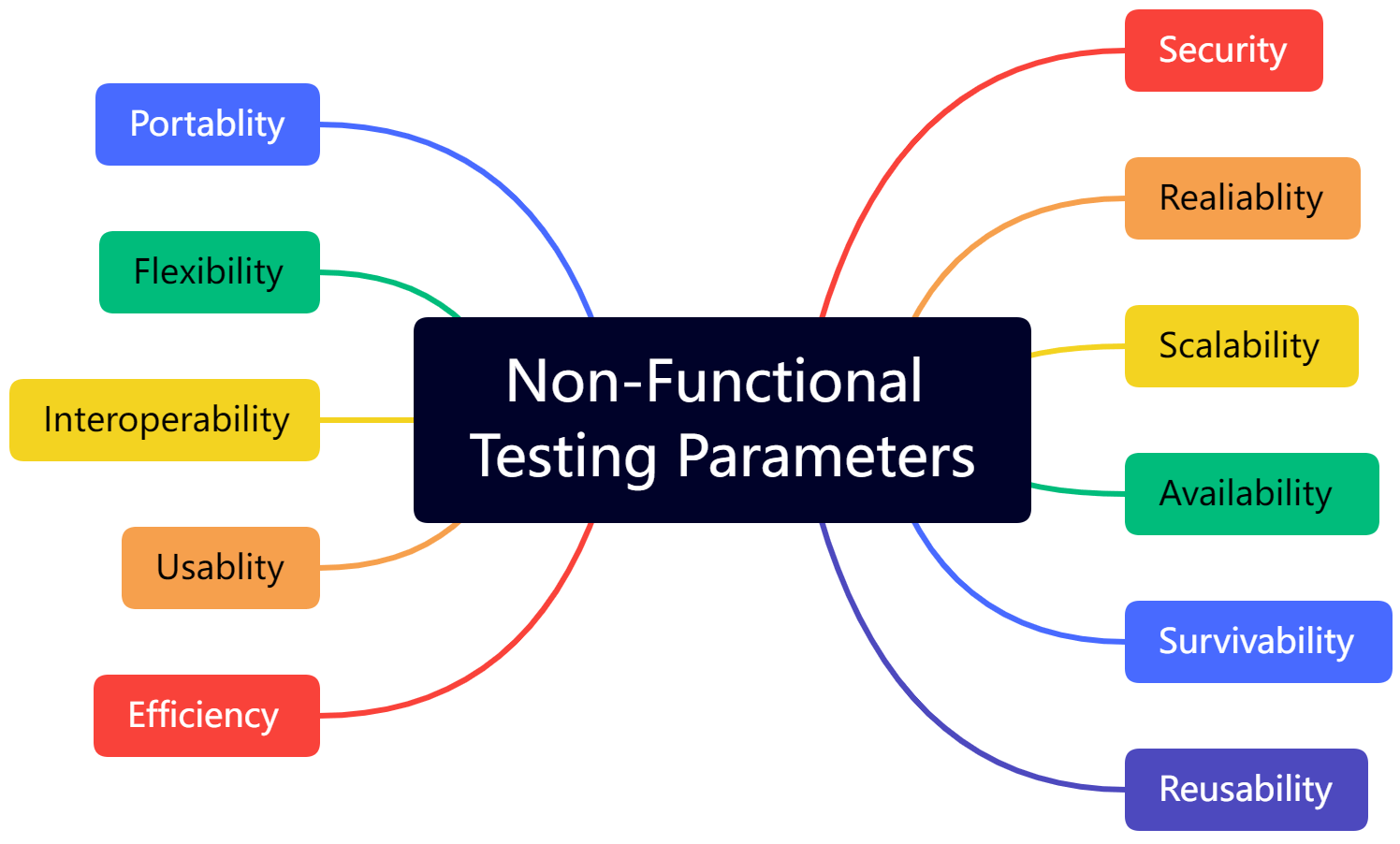
- Introduction to Non-Functional Testing
- Why is Non-Functional Testing Important?
- Key Objectives of Non-Functional Testing
- Functional vs Non-Functional Testing
- Types of Non-Functional Testing
- Performance Testing and Its Subtypes
- Security Testing and Its Subtypes
- Usability and Compatibility Testing
Introduction to Non-Functional Testing
Non-functional testing plays a vital role in ensuring that a software application not only works as expected but also performs efficiently under various conditions. Unlike functional testing, which focuses on what the system does, non functional testing evaluates how the system behaves including performance, scalability, reliability, usability, and security. For web-based solutions, non functional test cases for web applications might assess how fast a site loads under heavy traffic, how secure the login system is, or how accessible it is across different browsers and devices. These aspects are critical to user satisfaction and system robustness. A solid testing strategy should include both functional and non functional tools to deliver a high-quality product. While functional tools validate core features, non-functional tools help monitor metrics like server response times, data handling, and system recovery after failure. For example, tools like JMeter, LoadRunner, and Lighthouse are commonly used to evaluate non-functional aspects. By incorporating non-functional testing early in the development process, teams can identify performance bottlenecks and system vulnerabilities before they impact users, ultimately saving time, cost, and reputation. This type of testing ensures that the final product is not only functional but also efficient, reliable, and ready to meet real-world demands.
Are You Interested in Learning More About Software Testing? Sign Up For Our Software Testing Certification Training Today!
Why Is Non-Functional Testing Important?
- Enhances Security: With growing cyber threats, penetration testing and website security checks are essential to safeguard sensitive user data and prevent system breaches.
- Improves Performance: It ensures your application performs well under peak loads, helping avoid slow response times or crashes during high traffic.
- Validates Reliability: Non-functional testing confirms that the system is stable and reliable over time, even after prolonged use or under stressful conditions.
Non-functional testing is crucial because it ensures that a software application performs optimally under various conditions, beyond just delivering expected functionality. It focuses on aspects like speed, security, scalability, and usability factors that greatly influence user satisfaction and system reliability. Incorporating non-functional testing early in development helps detect hidden issues that could lead to serious failures post-release. Here are six reasons why non-functional testing is important:

- Supports Compliance: Many industries require applications to meet specific non-functional requirements. NFR testing tools help ensure compliance with these standards.
- Optimizes User Experience: Usability testing evaluates how intuitive and user-friendly your application is, directly impacting user engagement and retention.
- Boosts Automation Efficiency: Tools like Microfocus UFT and UFT automation allow testers to automate non-functional test scenarios, making the process faster and more accurate.
Key Objectives of Non-Functional Testing
The key objectives of non functional testing revolve around validating how well a software system performs under various conditions, rather than just checking if it functions correctly. It aims to ensure that the application is reliable, scalable, secure, and user-friendly. One of its primary goals is to evaluate system performance, including load handling, response time, and stability during peak usage. In the case of web-based systems, non functional test cases for web applications may include testing how the website behaves under high traffic, how quickly it responds, and how it performs across different browsers and devices. These factors are critical to user experience and customer satisfaction. Another important objective is to assess system security, especially against unauthorized access or data breaches. Tools play a vital role in this process functional and non functional tools are used in tandem to create a balanced testing strategy. While functional tools verify whether specific features work as intended, non-functional tools help evaluate underlying performance metrics and system behaviors. By addressing these objectives, non-functional testing ensures that the software is not only functional but also efficient, secure, and ready for real-world use. This ultimately contributes to higher software quality, reduced risk, and enhanced customer trust.
To Explore Software Testing in Depth, Check Out Our Comprehensive Software Testing Training Course To Gain Insights From Our Experts!
Functional vs Non-Functional Testing
- Purpose: Functional testing checks core functionalities like login, search, and form submissions, while non-functional testing evaluates aspects such as performance, scalability, and usability.
- Test Focus: Functional testing ensures the system behaves according to requirements, whereas non-functional testing covers performance metrics like response time, load capacity, and recovery.
- Security Testing: Functional testing might confirm if a user can log in, but non-functional testing includes penetration testing and website security checks to protect against vulnerabilities.
Understanding the difference between functional and non-functional testing is essential for building robust, high-performing software. While functional testing verifies what the system does ensuring each feature works as expected, non-functional testing focuses on how the system performs under various conditions. Both are necessary to deliver a reliable and user-friendly application.

- Tools Used: Functional testing often uses tools like Selenium, while non-functional testing leverages NFR testing tools such as LoadRunner or JMeter.
- Automation Approach: Both can be automated, but UFT automation using Microfocus UFT supports integrated testing of functional and some non-functional aspects within a unified framework.
- Outcome & Value: Functional testing ensures correctness, while non-functional testing ensures the application is efficient, secure, and reliable under real-world conditions.
Types of Non-Functional Testing
Non-functional testing encompasses a variety of test types aimed at evaluating how a software system performs, rather than what it does. Each type focuses on specific attributes like speed, security, scalability, and reliability to ensure the application can handle real-world demands. One of the most critical types is performance testing, which includes load, stress, and scalability testing to measure system responsiveness and stability under different conditions. Security testing, including penetration testing and website security checks, helps identify vulnerabilities and protect against unauthorized access or data breaches. Usability testing focuses on user experience by assessing the interface’s intuitiveness and ease of navigation. Compatibility testing ensures the application runs smoothly across various devices, browsers, and operating systems. Reliability and maintainability testing assess the system’s stability and how easily it can be updated or fixed. All these types are supported by various NFR testing tools like LoadRunner, JMeter, and others. Moreover, tools such as Microfocus UFT enhance test automation by supporting both functional and certain non-functional tests through UFT automation. By combining these diverse testing types, teams can ensure a secure, high-performing, and user-friendly application that stands up to real-world usage and customer expectations.
Performance Testing and Its Subtypes
- Load Testing: Simulates a typical number of concurrent users to verify how the system handles expected traffic without degrading performance. It checks for slowdowns, errors, or timeouts during peak hours, ensuring smooth usability during regular business operations.
- Stress Testing: Pushes the application beyond its maximum operational capacity to identify breaking points. It helps uncover how the system behaves under pressure such as during Black Friday sales or sudden API spikes and whether it fails gracefully or crashes unexpectedly.
- Spike Testing: Introduces sudden and extreme bursts of traffic to observe how the application reacts. This test checks whether the system can scale instantly and return to normal functionality quickly, helping to prepare for real-time user surges or viral traffic spikes.
- Endurance Testing (Soak Testing): Involves running the system under a normal load for an extended period to detect performance degradation, memory leaks, or system fatigue. It ensures the application can maintain consistent performance over long durations without slowing down or crashing.
- Volume Testing: Focuses on evaluating the application’s ability to handle large volumes of data, such as massive file uploads or high-volume database operations. It ensures that data processing does not affect system integrity or result in data loss or corruption.
- Scalability Testing: Measures how well the system scales when the number of users, transactions, or resources increases. It verifies whether the application can maintain performance by scaling up (adding resources) or out (adding servers) without bottlenecks or system lag.
Performance testing is a fundamental part of non functional testing that ensures a software application performs efficiently under various user loads and conditions. It focuses on how a system responds, scales, and maintains stability over time rather than just what it does functionally. In real-world scenarios, non functional test cases for web applications are used to examine how a website performs during peak traffic, heavy data processing, or prolonged usage. To achieve reliable results, QA teams rely on a combination of functional and non functional tools that simulate user activity and monitor performance metrics in detail. Below are the key subtypes of performance testing with expanded insights:
Each of these testing types is crucial for delivering a robust, scalable, and high-performing product. By leveraging powerful functional and non functional tools, QA teams can proactively identify and fix performance issues before the application goes live, ensuring a seamless experience for users under any conditions.
Security Testing and Its Subtypes
Security testing is a crucial part of ensuring software resilience against cyber threats and unauthorized access. It aims to uncover vulnerabilities, loopholes, and risks in an application that could be exploited by attackers. One of the most widely used approaches is penetration testing, which simulates real-world attacks to identify security weaknesses before malicious users do. Another vital aspect is the website security check, which ensures web applications are protected against threats like SQL injection, XSS, and data breaches. Security testing includes various subtypes such as vulnerability scanning, ethical hacking, security auditing, risk assessment, and posture assessment, each targeting a different area of application safety. To perform these effectively, testers often rely on NFR testing tools like Burp Suite, Nessus, and OWASP ZAP to scan and report vulnerabilities. Additionally, enterprise-grade tools like Microfocus UFT support certain security validations within broader automated testing strategies through UFT automation, making it easier to integrate security checks into continuous testing pipelines. Security testing not only strengthens the application’s defense but also ensures compliance with data protection regulations. When implemented thoroughly, it builds user trust and safeguards sensitive data, making it an indispensable component of any robust software development lifecycle.
Want to Pursue a Software Testing Master’s Degree? Enroll For Software Testing Master Program Course Today!
Usability and Compatibility Testing
Usability and compatibility testing are key components of non functional testing, focusing on the overall user experience and system accessibility across different platforms. Usability testing evaluates how intuitive, user-friendly, and efficient an application is from the end-user’s perspective. It checks whether users can navigate easily, complete tasks without confusion, and interact smoothly with the interface. On the other hand, compatibility testing ensures that the application performs consistently across various devices, browsers, operating systems, screen sizes, and network environments. These testing types are especially important when creating non functional test cases for web applications, where user behavior varies significantly based on technology usage. For instance, a web app must function identically on Chrome, Firefox, and Safari, while maintaining accessibility on both desktop and mobile devices. To execute these tests effectively, teams rely on a mix of functional and non functional tools such as Selenium for interface interaction and BrowserStack for cross-platform validation. By identifying and resolving issues related to user experience and platform compatibility early in the development cycle, organizations can significantly improve customer satisfaction, reduce bounce rates, and ensure that their application is inclusive and accessible to a broader audience, making it both technically strong and user-centered.

